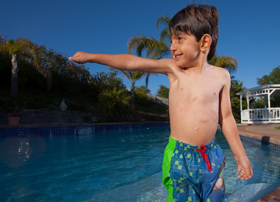Five years after lifesaving surgery at Rady Children’s, boy born with hole in diaphragm is leading a normal life
By Colleen McNatt 
When you greet William James Kalas, he may extend his right arm, but there will be no handshake.
Instead, his middle fingers are curled and the thumb, index finger and pinky stretched wide.
This is Will’s webslinger pose — Spiderman is his favorite superhero at the moment — and the look in his eyes tells you he’s a force to be reckoned with. Will may be small compared to most 5-year-olds, but he is mighty.
It would be impossible to guess, unless you look at Will’s scars, that he was born with a serious, life-threatening birth defect involving both his lungs and intestines.
His mother, Valerie, already had three daughters when she learned she was pregnant with Will. And during her pregnancy, she received frightening news: her fourth child would be born with a congenital diaphragmatic hernia, or CDH, and had only a 50/50 chance of survival.
In CDH, there is a hole in the diaphragm — the muscle used in breathing. Since the diaphragm separates the chest and the abdomen, the defect allows the intestines and other organs in the abdomen to move into the chest, preventing the lungs from developing normally.
CDH is not very common in newborns, occurring in only one of 3,000 live births, according to Marva Evans, M.D., director of the Neonatal Maternal-Fetal Program at Rady Children’s Hospital- San Diego and a professor of pediatrics at the University of California, San Diego.
Despite the odds given to Valerie, Dr. Evans said that 75-85 percent of the newborns with CDH treated at Rady Children’s survive, depending on the size of the defect and the side of the body on which it occurs. Rady Children’s Neonatal Intensive Care Unit has cared for more than 120 babies diagnosed with CDH in the past 10 years, with outcomes among the best in the world.
Immediately after Will’s birth, he was rushed to Rady Children’s NICU, where he spent the first 10 days of his life on ECMO (extracorporeal membrane oxygenation), commonly known as the heart-lung machine.
On day nine, Will had improved enough so that pediatric surgeon Barry LoSasso, M.D., director of the Center of Excellence for Chest Wall Deformities at Rady Children’s, was able to repair his hernia and take him off the ECMO machine the next day. Will gradually weaned off the regular respirator and supplemental oxygen and was able to breathe entirely on his own, but he was still not strong enough to feed on his own and gain weight.
Will also had gastroesophageal reflux disease, a condition linked to CDH that can cause pulmonary and nutritional problems. Dr. LoSasso performed an anti-reflux procedure to treat the disease and put in a feeding tube, enabling Will to receive supplemental nutrition for the first three years of his life. Once the tube was in place, Will participated in a weekly feeding group at Rady Children’s, facilitated by occupational therapist Ann Marie Mazzeo.
While Will was in the NICU, Valerie visited her son each day in between the carpools and extracurricular activities of her three daughters. Valerie’s husband John — a first-time father — leaned on her for her parenting expertise as their day-to-day journey in the NICU unfolded. It was during this time of extreme stress that members of the NICU staff proved to be the most important resource for Valerie and the source of some her most precious memories. She reminisces about Gillian Kirkpatrick, who was one of Will’s primary nurses.
Valerie and John formed a special bond with Gillian, who was there to assist and encourage Valerie on a particularly memorable day.
“She answered my prayers when one day she said, ‘Okay, it might take some time to sort out the tubes and wires, but today you are going to hold him!’” Valerie said.
Outside of the carpools, extracurricular activities, and dizzying schedule of raising four children, Valerie can still be found in the NICU five years later.
Every Thursday morning, she takes her turn holding newborns and soothing their agitated or frightened cries. Rady Children’s became such an integral part of her family’s life after Will’s birth that she found it a natural transition to volunteer and give back.
“Many of the same people who cared for Will when he was a patient are still in the NICU and ask about my family,” Valerie said.
As for Will, his medical condition is stable, and he no longer needs follow-up care.
Doctors say he will probably remain smaller in size, but that won’t stop Will from doing what he likes best: playing with his Legos, eating carrots, and honing his webslinger skills.
Originally published in U-T San Diego, October 2012